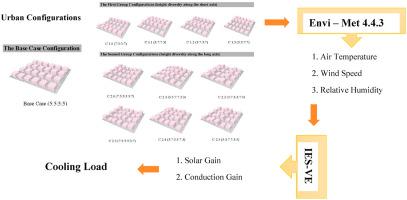Building and Environment ( IF 7.4 ) Pub Date : 2021-02-19 , DOI: 10.1016/j.buildenv.2021.107675 Sundus Shareef

|
The indoor air temperature and cooling load are highly affected by the surrounding environment. Enhancing outdoor thermal performance leads to a positive impact on energy consumption for cooling purposes, specifically in hot climate countries such as the UAE. The UAE weather characteristics specified as desert climate, however, it is more humid than the other cities with similar climate conditions. It has been found that a limited number of publications concern with the direct impact of urban morphology on the indoor cooling load within local climate conditions of the UAE. Moreover, the integrated and direct impact of height diversity on the indoor cooling load at an urban scale requires more investigation. This study aims to explore the impact of urban morphology, specifically height diversity on the cooling load within local climate conditions of the UAE. Furthermore, it aims to find an optimized cooling consumption prototype of an urban block to emphasize the study novelty. It adopts urban planning and building morphology to optimize the outdoor thermal performance and reflect this enhancement on indoor energy consumption. The results show that the orientation is the most influential factor in the urban block cooling load and energy consumption. It is significantly and directly control the amount of solar radiation and buildings solar gain. The minimum direct solar gain of the base case configuration concerning the orientation is recorded in the N–S with a reduction of 13% compared to the NE-SW orientation. This has resulted in a reduction in cooling load by 6.4% between these two orientations. Further to that, the reduction in outdoor air temperature and solar gain by implementing the building's height diversity resulted in a reduction in cooling load by 4.6% between the base case and the urban block configuration with the building's height diversity.
中文翻译:

城市形态和建筑高度多样性对城市规模能耗的影响。迪拜的案例研究
室内空气温度和制冷负荷受周围环境的影响很大。增强室外热性能会对冷却目的的能源消耗产生积极影响,特别是在阿联酋这样的炎热气候国家。阿联酋的天气特征被指定为沙漠气候,但是比其他气候条件相似的城市更潮湿。已经发现,在阿联酋当地气候条件下,数量有限的出版物涉及城市形态对室内制冷负荷的直接影响。而且,高度多样性对城市规模的室内制冷负荷的直接综合影响还需要进一步研究。这项研究旨在探讨城市形态的影响,特别是在阿联酋当地气候条件下,冷却负荷的高度差异。此外,它的目的是找到一个优化的城市街区制冷消耗原型,以强调研究的新颖性。它采用城市规划和建筑形态来优化室外热性能,并将这种增强反映在室内能耗上。结果表明,取向是影响城市街区制冷负荷和能耗的最主要因素。它可以直接有效地控制太阳辐射量和建筑物的太阳增益。与N-SW方向相比,在N–S中记录了与方向有关的基本案例配置的最小直接太阳增益,减少了13%。这导致这两个方向之间的冷却负荷降低了6.4%。


























 京公网安备 11010802027423号
京公网安备 11010802027423号